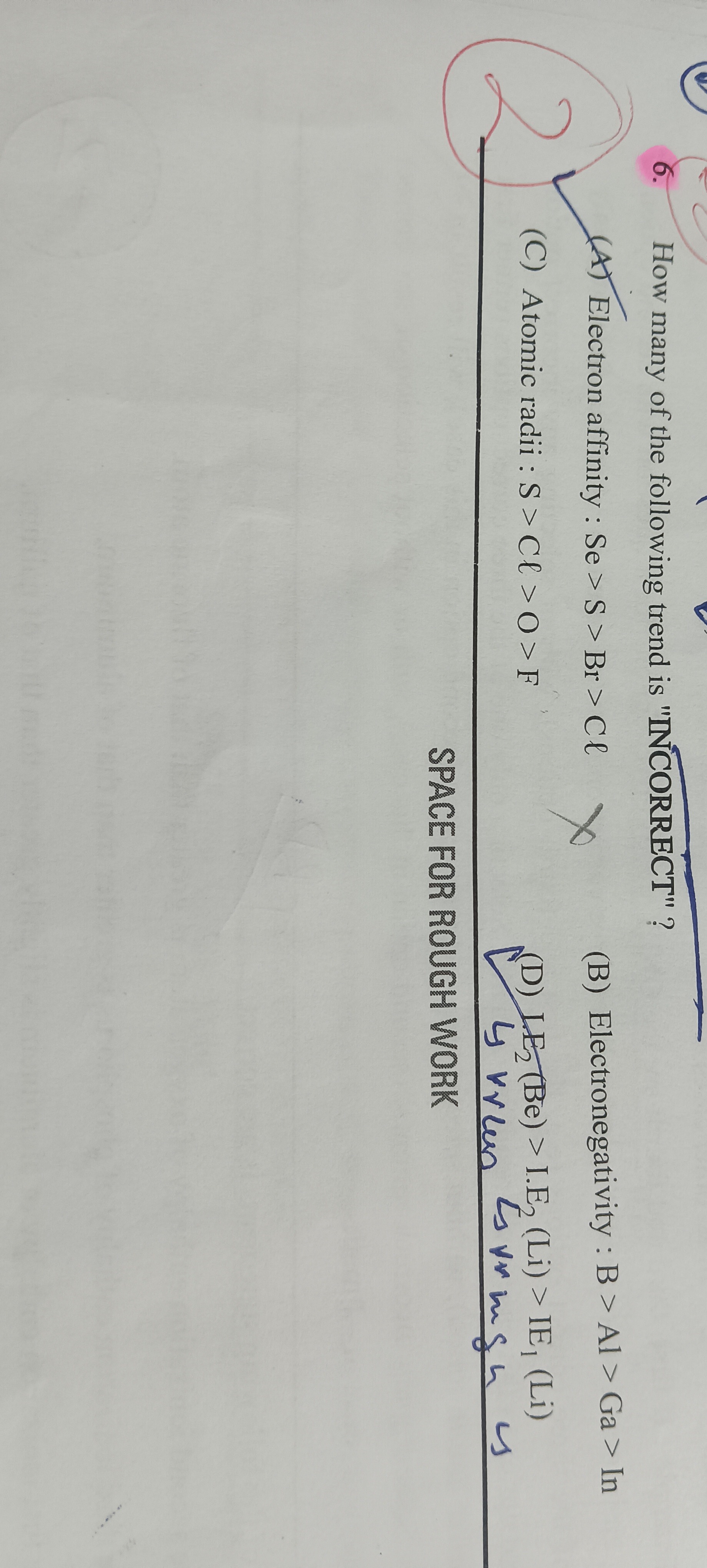Question
Question: How many of the following trend is "INCORRECT" ?...
How many of the following trend is "INCORRECT" ?

Electron affinity : Se > S > Br > Cl
Electronegativity : B > Al > Ga > In
Atomic radii : S > Cl > O > F
IE2(Be)>I.E2(Li)>IE1(Li)
3
Solution
The question asks us to identify the number of incorrect trends among the given options. Let's analyze each option:
(A) Electron affinity : Se > S > Br > Cl
-
Electron affinity (EA) generally increases across a period and decreases down a group.
-
There's an anomaly: Second-period elements (like O, F) generally have lower electron affinities than their third-period counterparts (S, Cl) due to their small size and increased interelectronic repulsion.
-
Comparing within a group (downwards): EA decreases.
- Group 16: S > Se
- Group 17: Cl > Br
-
Comparing within a period (left to right): EA generally increases.
- Period 3: Cl > S
- Period 4: Br > Se
-
Combining these facts:
- Cl has the highest electron affinity among halogens and generally among non-metals.
- Comparing Cl and S (both Period 3): Cl > S.
- Comparing Br and Se (both Period 4): Br > Se.
- Comparing S and Br: S is in Period 3, Br in Period 4. Cl > S and Cl > Br. Br is more electronegative than S, so Br has higher electron affinity than S. (Actual values: Cl (-349 kJ/mol) > Br (-325 kJ/mol) > S (-200 kJ/mol) > Se (-195 kJ/mol)).
-
Therefore, the correct order is: Cl > Br > S > Se.
-
The given trend Se > S > Br > Cl is INCORRECT.
(B) Electronegativity : B > Al > Ga > In
-
Electronegativity (EN) generally decreases down a group.
-
For Group 13 elements (B, Al, Ga, In, Tl), the expected trend would be B > Al > Ga > In > Tl.
-
However, due to the poor shielding effect of d-electrons (in Ga) and d & f-electrons (in Tl), the effective nuclear charge for Ga and Tl is higher than expected. This causes an anomalous trend in electronegativity.
- Ga has higher EN than Al (Ga > Al) because of the poor shielding by 3d electrons in Ga.
- Tl has higher EN than In (Tl > In) because of the poor shielding by 4f and 5d electrons in Tl.
-
The actual trend for Group 13 electronegativity is approximately: B > Tl ≈ Ga ≈ In > Al.
-
Since Al < Ga, the given trend B > Al > Ga > In is INCORRECT.
(C) Atomic radii : S > Cl > O > F
-
Atomic radii generally decrease across a period (from left to right) and increase down a group (from top to bottom).
-
Within Period 2: Oxygen (O) is to the left of Fluorine (F). So, O > F.
-
Within Period 3: Sulfur (S) is to the left of Chlorine (Cl). So, S > Cl.
-
Comparing across periods (down a group):
- Sulfur (S) is below Oxygen (O). So, S > O.
- Chlorine (Cl) is below Fluorine (F). So, Cl > F.
-
Combining these: S is the largest, followed by Cl (smaller than S, but larger than O and F). O is larger than F.
-
Therefore, the correct order is: S > Cl > O > F.
-
The given trend S > Cl > O > F is CORRECT.
(D) IE2(Be)>I.E2(Li)>IE1(Li)
- Ionization Energy (IE) is the energy required to remove an electron.
- IE1(Li): Removal of the first electron from Li (1s22s1→1s2). This is the removal of a 2s electron.
- IE2(Li): Removal of the second electron from Li+ (1s2→1s1). This involves removing an electron from a completely filled inner 1s shell (noble gas configuration). This requires a very large amount of energy.
- IE2(Be): Removal of the second electron from Be+ (1s22s1→1s2). This involves removing a 2s electron from a cation.
- Comparing IE2(Li) and IE2(Be): IE2(Li) involves removing an electron from a stable 1s2 configuration, which is much harder than removing a 2s electron from Be+. So, IE2(Li) must be significantly greater than IE2(Be).
- Comparing IE2(Be) and IE1(Li): Both involve removing a 2s electron. However, for IE2(Be), the electron is removed from Be+ (a cation with Z=4), while for IE1(Li), it's removed from neutral Li (Z=3). The effective nuclear charge on the 2s electron in Be+ is much higher than in Li. Thus, IE2(Be)>IE1(Li).
- Therefore, the correct order is: IE2(Li)>IE2(Be)>IE1(Li).
- The given trend IE2(Be)>I.E2(Li)>IE1(Li) is INCORRECT.
Out of the four trends, (A), (B), and (D) are incorrect. So, there are 3 incorrect trends.
